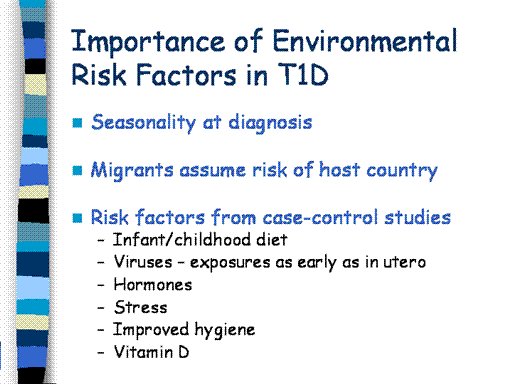| front |1 |2 |3 |4 |5 |6 |7 |8 |9 |10 |11 |12 |13 |14 |15 |16 |17 |18 |19 |20 |21 |22 |23 |24 |25 |26 |27 |28 |29 |30 |31 |32 |33 |34 |35 |36 |37 |38 |39 |40 |41 |42 |43 |44 |45 |46 |47 |48 |49 |50 |51 |52 |53| 54 |review |
 |
There are
several epidemiologic patterns that suggest that environmental factors
are important in the etiology of T1D.
For example, the diagnosis of T1D is more common during the cold
winter months compared to the summer.
This parallels the seasonal patterns observed for infectious
diseases, which have been suggested as risk factors.
In addition,
when children from countries with a low T1D incidence rate migrate to
countries with a high T1D incidence rate, their risk increases and
becomes similar to that for the host country.
This difference is much less dramatic for individuals who migrate
during their adult years, indicating that the childhood exposures are
probably most diabetogenic.
Studies that
have compared children with T1D to unrelated non-diabetic children
(i.e., case-control studies) have shown that several environmental risk
factors are important in the etiology of T1D.
These include infant / childhood diet.
For example, breast feeding appears to be protective, and early
exposure to cow’s milk increases T1D risk.
A number of viral infections have also been associated with T1D.
These include those that occur in utero during pregnancy,
as well as those that typically occur during childhood (e.g.,
enteroviruses). Because the peak
onset of T1D is at puberty, it is thought that changing levels of
hormones may also precipitate the disease.
Finally, stress has been suggested as a T1D risk factor.
Many parents report that their child experienced a very stressful
event (e.g., divorce) just prior to the onset of the disease.
The role of
improved hygiene in the etiology of T1D is also currently being
explored. It has been
hypothesized that delayed exposure to microorganisms due to improvements
in standard of living hinders the development of the immune system, such
that it is more likely to respond inappropriately when introduces to
such agents at older (compared to younger) ages.
This explanation is consistent with recent reports indicating
that factors such as day care attendance, sharing a bedroom with a
sibling and contact with pets are protective against T1D. Further
studies are needed to determine if improved hygiene can explain the
temporal increases in the incidence of T1D worldwide.
|